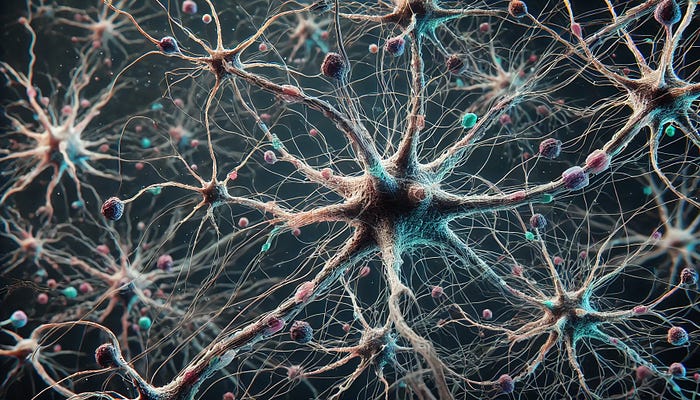Exploring the Impact of Artificial Intelligence on Human Neural Network Development

4 min read
·
Jun 28, 2024
- -
AbstractThe integration of artificial intelligence (AI) into daily life and its influence on the human brain’s neural networks poses profound implications for cognitive development, behavior, and neuroplasticity. This article examines the interplay between AI and the human neural network, evaluating both the potential enhancements and challenges that AI introduces. It explores how AI technologies can mimic, supplement, and even enhance human cognitive processes, as well as the potential risks associated with its pervasive use.

Introduction
Artificial Intelligence has permeated various aspects of human life, from enhancing learning experiences to automating tasks, thus reshaping the landscape of human interaction and cognitive processes. The human brain, known for its plasticity, continually adapts and responds to new stimuli, including interactions with AI systems. This dynamic relationship raises pivotal questions about the implications of AI on the human neural network — specifically, how continuous exposure to and reliance on AI systems could sculpt and potentially alter neural pathways.
AI as a Cognitive Enhancer
AI’s role as a cognitive tool is evident in educational technologies, therapeutic applications, and personalized learning environments. AI systems can process vast amounts of data to provide customized feedback, enhance learning efficiency, and identify patterns that are imperceptible to humans. For instance, AI-driven programs in language learning can adapt to the learner’s proficiency level, providing practice and reinforcement that are optimally timed to the learner’s ability to absorb new information, thereby reinforcing neural pathways associated with language acquisition.
Case Study: AI in Therapeutic Settings
AI’s application in therapy, such as in cognitive-behavioral therapy (CBT) tools, illustrates its capacity to guide users through various mental health therapies, effectively reinforcing therapeutic practices that aim to alter problematic neural pathways. AI-enabled CBT platforms utilize algorithms to provide mental health support, which can help users practice new cognitive strategies that reshape neural circuits associated with mental health disorders.
Challenges and Risks
Despite the benefits, reliance on AI poses challenges including cognitive atrophy and privacy concerns. Cognitive atrophy might occur when individuals rely heavily on AI for tasks that previously required significant mental effort. This can lead to a ‘use it or lose it’ scenario, where less engagement in complex cognitive processes results in a decline in those neural functions.
Privacy and Neurosecurity
As AI systems become more integrated with personal data to function effectively, there is an increasing risk of breaches involving sensitive information, including biometric data that can map an individual’s neural activities. This raises significant concerns about neurosecurity, where an individual’s neural data could be exploited or manipulated, leading to unprecedented forms of privacy invasion.
Neuroplasticity and Long-term Implications
The plastic nature of the human brain allows it to adapt to the tools it uses most frequently. Continuous interaction with AI can lead to significant neuroplastic changes, potentially enhancing cognitive functions such as pattern recognition and problem-solving skills. However, these changes could also make the brain more reliant on AI tools, reducing its ability to perform certain tasks independently.
Future Research Directions
As the integration of AI into everyday life continues to expand, future research should focus on several key areas:
Longitudinal Studies
Longitudinal studies are essential to understand the long-term effects of AI on the human neural network. Such studies would help in tracking changes in cognitive functions over time, providing insights into how prolonged exposure to AI impacts cognitive decline or enhancement.
AI Interaction Models
Developing sophisticated models to simulate and predict the outcomes of human-AI interaction can provide deeper insights into potential neural adaptations. These models can help identify which AI features or behaviors contribute to beneficial neural plasticity and which might lead to cognitive atrophy.
Ethical Frameworks
Given the potential for neurosecurity breaches and privacy issues, it is crucial to establish robust ethical frameworks and guidelines to govern the use of AI, especially those interfacing closely with human cognitive functions. These frameworks should address consent, data protection, and the right to cognitive liberty.
Cross-disciplinary Approaches
Incorporating insights from neuroscience, cognitive psychology, computer science, and ethical studies can provide a holistic view of how AI impacts the human brain. This approach ensures that applications of AI are developed with an understanding of their broad societal and psychological impacts.
Conclusion
The relationship between AI and the human neural network is complex and multi-faceted, presenting both opportunities for cognitive enhancement and challenges that could alter fundamental aspects of human cognition. Future research should aim to understand the long-term impacts of AI on the neural pathways, particularly in how the brain adapts to these technologies. It is crucial to balance the benefits of AI in enhancing human capabilities with the risks it poses to cognitive independence and privacy.
References
For further reading and to explore more about AI’s impact on cognitive functions and neuroplasticity, the following resources provide comprehensive insights:
- “Natural and Artificial Intelligence: A brief introduction to the interplay between AI and neuroscience research” — ScienceDirect
- “AI-Rehab: A Framework for AI Driven Neurorehabilitation Training — The Profiling Challenge” — Academia.edu
- “Privacy in the Age of Neurotechnology: Investigating Public Attitudes towards Brain Data Collection and Use” — Association for Computing Machinery
- “A New World of Learning” — Research Gate
- “Application of artificial intelligence in cognitive load analysis using functional near-infrared spectroscopy: A systematic review” — ScienceDirect
Did you find this article valuable? We can help your business make an impact with professionally crafted content.
